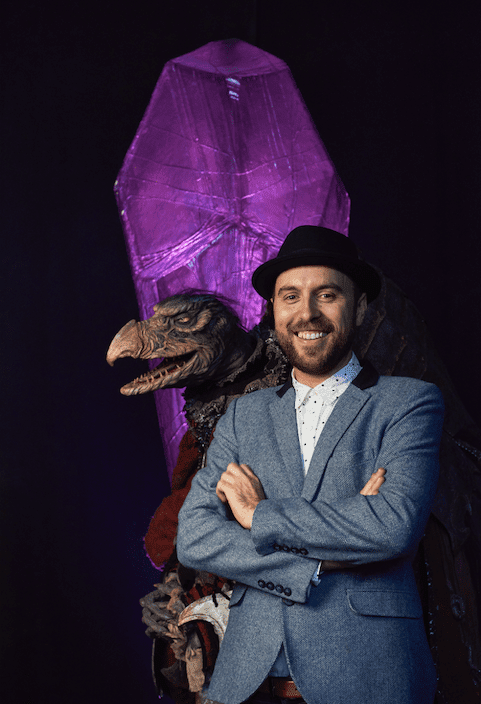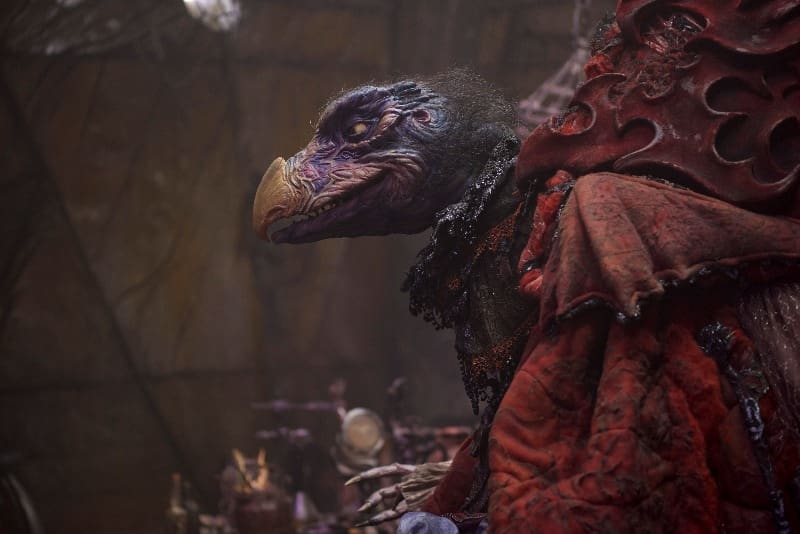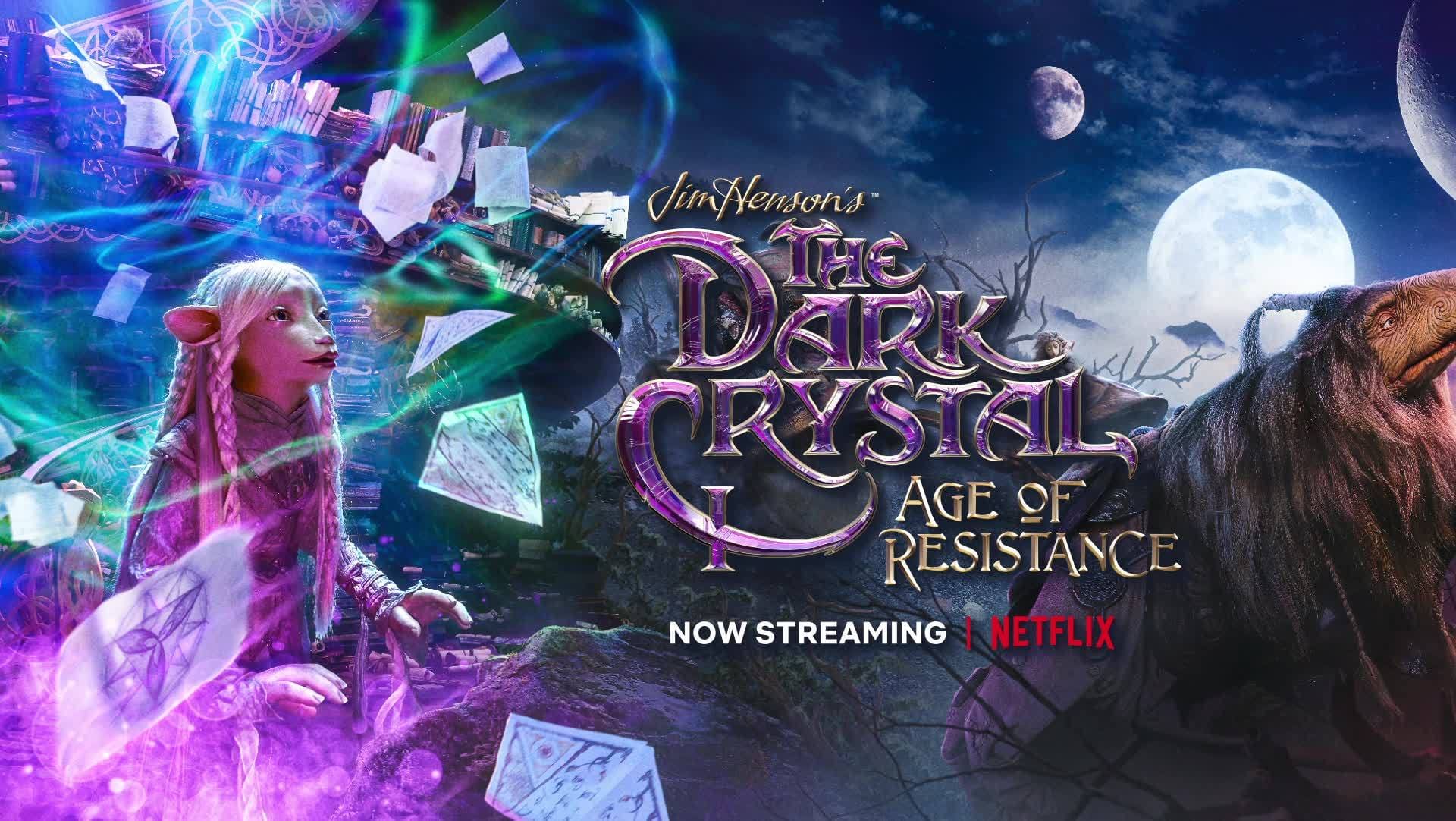The internet, and pop culture world is abuzz about Netflix’s The Dark Crystal: Age of Resistance — the prequel series to Jim Henson’s cult classic, The Dark Crystal. The news, reviews, and interviews surrounding this series have been overwhelmingly positive. And such an amazing series based on such an amazing is definitely deserving of such praise and recognition.
Even more deserving of praise and recognition are the people who worked on the show — in particular the people behind the breathtaking puppets used throughout the series. I had the opportunity to speak with one of Dark Crystal: Age of Resistance‘s lead puppeteers, Warrick Brownlow-Pike. In our conversation Warrick Brownlow-Pike and I discussed his experience as a puppeteers, what it’s like to work on such a vast, intricate show that so many people loved in 1982, and are falling in love with in 2019 due to this series.
The first thing I want to ask is why and how you got into puppeteering?
Warrick Brownlow-Pike: So, probably when I was around two years old was the first time I saw puppets on television and it was The Muppet Show. From the moment those curtains opened, I was hooked. I knew from that point on that this was going to be my life. It’s quite a short story, but it’s true.

Since then, I’ve just been working with and playing with puppets. We used to hook up the home video camera to the television, my mom was quite technical, so she knew how to do that and I would just lay on the floor with a puppet in the air, singing along to songs or lip-syncing songs and that’s really how I honed my craft. I was kind of taught through the television because I saw the masters at work there
That’s really awesome that your mom was so supportive and helpful.
Warrick Brownlow-Pike: She just wanted to give me what I needed to do those kind of things. Very early on we made our own puppets at home. In fact, you can see the first puppet we in built in the documentary, The Crystal Calls. The first puppet we ever built is in this documentary, which is just hilarious to me.
So, my opinion, The Dark Crystal is a classic. What is your relationship to that particular film?
Warrick Brownlow-Pike: For sure the movie’s a classic and has kind of become a cult great. Everybody who knows it loves it. I first came to that movie because it was one of the only video my local video store had to rent. So I had to run. So that, that was the first time I ever saw it. They had a couple of Muppet videos stuff since I check it out and, it’s just otherworldly isn’t it? There’s always some something else to look at. So I’d go back like every week and just get the same video and watch it over and over again. That was my first journey into that world.
So I guess this actually leads into my next question. Obviously you would want to know about the film you’re working on and you already know the Chamberlain is a really important character and one of the most well known in the Dark Crystal universe. So what were your feelings taking on that role?
Warrick Brownlow-Pike: I was very excited about taking on the role of The Chamberlain. I’m a massive fan of Frank Oz’s work – Frank Oz performed the character in the 1982 movie, and he brought so much too it. He’s a fantastic actor and a fantastic puppeteer, so in terms of the physical movement and stuff, all that language is there for me. I kind of knew that already because I’d seen the movie so much and I was a fan, so I didn’t really have to study, although I did go back and watch the movie so many times while making the series. But all that stuff was already in my head and I just knew the physicalities of him. I mean, it’s a tall order to perform a character after Frank Oz has performed it. I just did my very best at it.
Well, I loved the series. I binged it almost all in one sitting. Now, the Chamberlain and the Skeksis in general, they’re like really big. They have lots of facial expressions and they’re really expressive with their movement. What were some of the challenges of working with such large, detailed puppets?
Warrick Brownlow-Pike: These are the largest puppets I’ve ever dealt with. The heaviest too. All of the puppets on the show have a group of seven. There’s rarely a puppet on the show that’s controlled by just one person. So for instance, with the Chamberlain and all of the Skeksis, I’m the lead performer. So I’m watching the head, I’m delivering the lines and the acting of it, and I’m also performing the left hand. Then I have an assistant under my armpit, Kat Smee, and she would do the right arm. So from the outside it looks like that creature is living and all the movements are there.

We’ve worked together a lot so we’re really in tune with each other. And then the animatronics of the face would be performed by Don Austin. Don would be sat off set watching a monitor really close up, making sure that people were in the right place at the right time – making sure the snarl was there, or the frown, or the brows go up at the right moment, and after a while we were finely tuned in to each other. We wouldn’t really even have to have a discussion about what we needed to do because we all knew what the character needed.
Not counting myself, there are 12 core puppeteers on the show – Neil Sterenberg, Becky Henderson, Helena Smee, Kat Smee, Dave Chapmin, Alice Dinnean, Victor Yerrid, Olly Taylor, Kevin Clash, Louise Gold, and Damian Farrell. So all of us do those characters and then we have a massive support group.
That’s honestly a lot less than I expected just because there’s SO many creatures on this show.
Warrick Brownlow-Pike: I think it was reported somewhere that we had 83 puppeteers. It was hard to keep track of how many people were there. Dave Chapmin and I were assistant puppet captains to Kevin Clash and we were in charge of arranging people and scheduling them, like letting everyone know where they needed to be at what time and who would be doing what – and there are lots of different types of puppets to work with, we had a marionette puppets, shadow puppets.
I think the biggest creature we had though was the Nurlock, which was 20-30 feet long and needed 9 people to perform. There were four of us physically maneuvering the creature, then there are two people on pulleys to keep the beast up in the air, then you have a remote control mouth, remote control in-mouth, and remote control eyes and eye stalks, so each person was controlling a different part of that character but everybody’s so in sync that it looks like a living, sentient being.
It’s so interesting to think about it. So many people doing one thing and when you’re watching it, it’s so smooth that it’s hard to believe it’s all these different people and different parts.
Warrick Brownlow-Pike: Well, everybody is a master at their craft and everybody’s watching their monitor so they can see what’s happening. All those people are working for the best possible outcome so it looks the best possible on screen. What’s funny is you could be performing a big character like that in one scene but then in the next scene, you might be a blade of grass. You leave your ego at the door, really.
What were your thoughts on the looks of the puppets? I thought that there was a nice balance of a modern look, but also a clear throwback to the classic design.
Warrick Brownlow-Pike: With characters like the Chamberlain you can’t really change much because that’s an iconic look, isn’t it? But we were so lucky to have these different clans of Gelflings because they could redesign and rethink those characters, such as Deet being green. I think that’s fantastic, I love it. That’s a gorgeous looking puppet. We never would have expected that because of Jen and Kira, their colors aren’t designed like that. So I think we’re really lucky to have been able to have that.
I know everything is scenery obviously, but this world has been so expanded and it’s so big. What was it like being in Thra? What was your favorite piece of scenery to work on?
Warrick Brownlow-Pike: Wow, that’s a hard question. You know, we living in Jim Henson’s imagination and Brian Froud’s art work and that’s a pretty good place to spend your time. There was a moment when I walked on set with Neil Sterenberg and we came upon to the Crystal Chamber when the crystal was hanging and we walked through the back of the sensor, we came into the set and I had that moment of “I just walked into the television, I’m inside the TV”, and we had tears in our eyes because it’s so moving to all of sudden find yourself inside these environments. I mean, the forest set was vast. And probably alive.
Simon Pegg provided the voice of the Chamberlain. How much did you work with him on? As far as mastering the character and basically creating the character again?
Warrick Brownlow-Pike: It’s funny creating the character, because we’re all coming together to put that one character together. You know, there’s myself, Kat Smee, and Don Austin doing the visuals of the creature. I’d lay down, that guide to track, so I’d do the lies on the day in studio and then Simon would put the icing on the cake, you know, because luckily he doesn’t have to think about the wearing of the puppet. He can just finish it off polished. I think he’s done a wonderful job.
I agree. Since I sort of that curve ball at you with what your favorite piece of scenery was, I’ve got another to follow it up, what was your favorite moment performing on the series?
Warrick Brownlow-Pike: For me, the box gets ticked in my head when I was performing the Charmberlain and I’d see a frame or a couple of frames where it looked just like it did in the movie. I don’t know if those are my favorite moments, but that’s certainly when I kind of went, “Okay, you’re right track”. I mean I just loved all those moments when all the Skeksis were together. I got those lovely moments of sneaking around the corners and stuff.
As puppeteers, you often work in children’s television and most of my time is spent doing CBeebies, which is BBC preschool, our Sesame Street, and it’s very sweet, but you don’t get to play villains often. So you get to be a Skeksis and the performance is very broad, but then in the next scene – I have a Gelfling, the redhead paladin, and that’s such a subtle performance. You can’t be as broad as a Gelfling like you are with a Skeksis because it would get cartoony and just wouldn’t work. Then on the flip side, I have an old man Podling servant who brings food and drinks to the Skeksis and that’s a funny and cartoony, so you get to perform all these different types of characters in one show.
What about your favorite moment working on the series in general?
Warrick Brownlow-Pike: Well, the most fun we probably had was a day or two when we were filming the Podling pub and we were just dancing around, skipping around, screaming and shouting, we just really let loose that day. The Podlings had these jugs of beer, and the art department made these beautifully crafted drinks with foam on top of them and obviously, the puppeteers started to fling the foam at each other. And after doing some of the intense emotions and the stress of doing something likea Skeksis or a Gelfling being drained or dying, you need those Podling moments to let loose.
For my last question, what do you have next on the horizon for your career? Are you able to get to tell us if there’s any hope for a second season for The Dark Crystal: Age of Resistance?
Warrick Brownlow-Pike: For myself, I still perform my doggy character, Dodge T. Dog on Cbeebies, the preschool BBC channel in England, I’ve been performing him for 12 years now. I also have a character on Seasame Street called Gonger, so that takes up all of my time. But I can’t tell you anything about The Dark Crystal, I’m sorry. Although, it got to me a couple of days ago, it’s been such a funny journey. You know, Jim Henson and Jane Henson started working with puppets back in 1955 and they would do this little show with just the two of them lip-syncing to comedy records. And it’s funny to draw the line from that all the way up to the present day, where this is the biggest puppet production ever, and it makes me feel really proud to be part of that.


